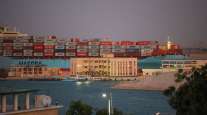Senior Reporter
AAPA Report Shows Growing Importance of Port System

[Stay on top of transportation news: Get TTNews in your inbox.]
WASHINGTON — As the world economy continues to become more globalized, a new report compiled for the American Association of Port Authorities shows that the nation’s ports and maritime industry in 2023 played a critical role in the growth.
Seaports and inland facilities employed an estimated 2.5 million workers, earning $214 billion in annual wages and benefits and generating $311 billion toward the gross domestic product.
The report, by Ernst and Young, was released March 19 at AAPA’s annual Legislative Summit and presented to more than 200 port leaders and the association’s board.
While the global economy is recalibrating in the aftermath of COVID-19, the port’s industry leadership says it is poised to take a more prominent role in developing the new economy.
Port leaders are cautiously optimistic about 2024.
The #shipping industry is keeping a watchful eye on developments in #panamacanal, #middleeast. Story by Dan Ronan. #cargo #oceanshipping #logistics
For the full article, visit: https://t.co/JsjI4NZh1J pic.twitter.com/w4FBpWsEI6 — Transport Topics (@TransportTopics) January 9, 2024
The report shows that is happening. It is estimated that $5.1 trillion worth of goods were imported and exported last year, and 40%, or $2.1 trillion, of all goods entered or left the U.S. through a port.
“Ports not only facilitate an extraordinary volume of trade but also serve as essential gateways for tourism, further diversifying their contribution to the economy,” the report said.
“That $2.1 trillion figure in direct goods flowing through our ports shows the underlying health of the U.S. economy,” Cary Davis, AAPA president and CEO, told the audience. “We are going to raise our voices to the lawmakers on Capitol Hill. We are going to tell them we need to grow the port coalition and pass the Port Act to get shovels in the ground on infrastructure projects.”
The Port Infrastructure Development Program is a $2.25 billion discretionary grant program administered by the Maritime Administration. The money is awarded to improve the safety, efficiency or reliability of the movement of goods into, out of, around or within a port.
Regarding jobs, the report said the maritime industry directly employs more than 290,000 workers, including dockworkers, tugboat pilots, cruise ship crews, commercial fishermen, shipbuilders and naval architects.
Meghann Erhart of Relay Payments shares ways to prevent falling prey to fuel card skimming. Tune in above or by going to RoadSigns.ttnews.com.
The transportation sector also is a considerable port employer, and the supply chain is becoming increasingly interconnected. The report noted that more than 90% of goods arriving or leaving a port do so on a truck, in a railcar or through a pipeline. The industry directly supports 425,000 trucking, rail, pipeline, warehousing and logistics jobs that reach beyond the coasts, lakeshores, and rivers in the U.S.
The report said port and maritime workers are some of the highest paid in the country, with their wages 20% above the national average. The average worker earned approximately $98,000 in wages and benefits in 2023. The port and maritime industry’s 1 million directly employed workers earned $100 billion in wages and benefits last year and generated $124 billion of GDP.
“We need to continue investing the time and energy to tell the story and the needs of the port industry, and be a part of something greater than the individual; that is our goal,” Davis emphasized.
Ports are embarking on a period of intense construction and redevelopment. The Infrastructure Investment and Jobs Act directs nearly $20 billion in federal spending over five years to upgrade the facilities. However, substantially more money is being spent by individual port authorities, along with state and local governments, on new construction, repairs and dredging.
The U.S. Census Bureau said that in 2021, state and local governments spent $6.8 billion on sea and inland port facilities. The most recent AAPA survey found that ports planned on spending more than $163 billion in capital expenditures between 2021 and 2025, which could increase in future years.

"We have to have a system of reliable information," Federal Maritime Commission member Carl Bentzel says. (Dan Ronan/Transport Topics)
Meanwhile, Federal Maritime Commission member Carl Bentzel updated delegates on his proposed Maritime Transportation Data Initiative, which he said will significantly improve supply chain connectivity by adding more transparency and having shippers share data about where a commodity or product is in the supply chain, from the moment it is loaded on a ship to the time it arrives at its destination.
Bentzel says the technology is available to do this on a large scale, but the industry is resisting those efforts.
“Ocean carriers should provide information related to their schedules, arriving at all U.S. ports, in advance of coming, every three months, and this information should be updated on a real-time basis,” Bentzel said. “I can take my kids to Disneyland or Disney World, and I can find out to the minute when there is service and other information. But if you want to find out when an ocean shipping company is providing service, the information is five weeks old.
“We have to have a system of reliable information. I don’t care how they get it, but we need requirements to provide better information. Everyone can see where a ship is in transit, but we don’t know when they plan to come into port.”
Bentzel says he is working closely with the four other members of FMC, and he hopes it can move forward later this year.
Want more news? Listen to today's daily briefing below or go here for more info:





